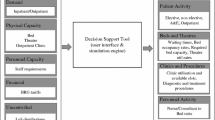Abstract
This paper describes how system dynamics was used as a central part of a whole-system review of emergency and on-demand health care in Nottingham, England. Based on interviews with 30 key individuals across health and social care, a ‘conceptual map’ of the system was developed, showing potential patient pathways through the system. This was used to construct a stock-flow model, populated with current activity data, in order to simulate patient flows and to identify system bottle-necks. Without intervention, assuming current trends continue, Nottingham hospitals are unlikely to reach elective admission targets or achieve the government target of 82% bed occupancy. Admissions from general practice had the greatest influence on occupancy rates. Preventing a small number of emergency admissions in elderly patients showed a substantial effect, reducing bed occupancy by 1% per annum over 5 years. Modelling indicated a range of undesirable outcomes associated with continued growth in demand for emergency care, but also considerable potential to intervene to alleviate these problems, in particular by increasing the care options available in the community.



Similar content being viewed by others
References
http://www.nottinghm-ha.trent.nhs.uk, downloaded Oct 21, 2002.
Audit Commission (1996). By Accident or Design: Improving A&E Services in England and Wales. HMSO: London.
Audit Commission (2001). Accident and Emergency Acute Hospital Portfolio: Review of National Findings. Audit Commission: London.
Lattimer VA et al (2004). Reviewing emergency care systems I: insights from system dynamics modelling. Emerg Med J, In press.
Gerard K et al (2004). Reviewing emergency care systems II: measuring patient preferences using a discrete choice experiment. Emerg Med J, In press.
Brailsford SC and Hilton NA (2001). A comparison of discrete event simulation and system dynamics for modelling healthcare systems. In: Riley J (ed) Proceedings from ORAHS 2000, Glasgow, Scotland, pp 18–39.
Forrester JW (1961). Industrial Dynamics. MIT Press: Cambridge, MA.
Forrester JW (1960). The impact of feedback control concepts on the management sciences. In: Collected Papers of J.W. Forrester (1975 collection), Wright-Allen Press: Cambridge, MA, pp 45–60.
Jun JB, Jacobson SH and Swisher JR (1999). Application of discrete-event simulation in health care clinics: a survey. J Opl Res Soc 50: 109–123.
Dangerfield BC and Roberts CA (1990). Modelling the epidemiological consequences of HIV infection and AIDS: a contribution from Operational Research. J Opl Res Soc 41: 273–289.
Townshend JRP and Turner HS (2000). Analysing the effect of Chlamydia screening. J Opl Res Soc 51: 812–824.
Wolstenholme EF (1993). A case study in community care using systems thinking. J Opl Res Soc 44: 925–934.
Lane DC, Monefeldt C and Rosenhead JV (2000). Looking in the wrong place for healthcare improvements: A system dynamics study of an accident and emergency department. J Opl Res Soc 51: 518–531.
STELLA, High Performance Systems, 145 Lyme Road, Hanover, NH.
Department of Health (2002). Hospital Episode Statistics. Department of Health: London.
Lane DC (2000). You just don’t understand me: modes of failure and success in the discourse between system dynamics and discrete event simulation, Working paper no. LSEOR 00.34, London School of Economics.
Pidd M (1998). Computer Simulation in Management Science, 4th edn. Wiley: Chichester.
Department of Health (2001). Reforming Emergency Care, Downloadable from www.doh.gov.uk/capacityplanning/reformfirststeps.htm.
Bagust A et al (1999). Dynamics of bed use in accommodating emergency admissions: stochastic simulation model. BMJ 319: 155–159.
Cooke MW, Wilson S and Pearson S (2002). The effect of a separate stream for minor injuries on accident and emergency department waiting times. Emerg Med J 19: 28–30.
Simul8, www.Simul8.com.
Shrimpling M (2002). Redesigning triage to reduce waiting times. Emerg Nurse 10: 34–37.
Acknowledgements
We thank the health and social care staff who assisted us in the conduct of this study and Dr Stephen Shortt, Mr James Scott, Mr John MacDonald, Dr Doug Black and the local steering committee for their contribution. We also thank Mr Steve Baxter and Mr Shaun Leah for their assistance in providing data. Nottingham Health Authority funded the project but the views expressed in the paper are those of the authors alone.
Author information
Authors and Affiliations
Corresponding author
Rights and permissions
About this article
Cite this article
Brailsford, S., Lattimer, V., Tarnaras, P. et al. Emergency and on-demand health care: modelling a large complex system. J Oper Res Soc 55, 34–42 (2004). https://doi.org/10.1057/palgrave.jors.2601667
Received:
Accepted:
Published:
Issue Date:
DOI: https://doi.org/10.1057/palgrave.jors.2601667



